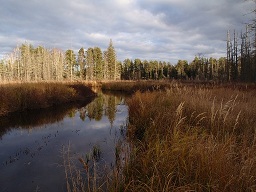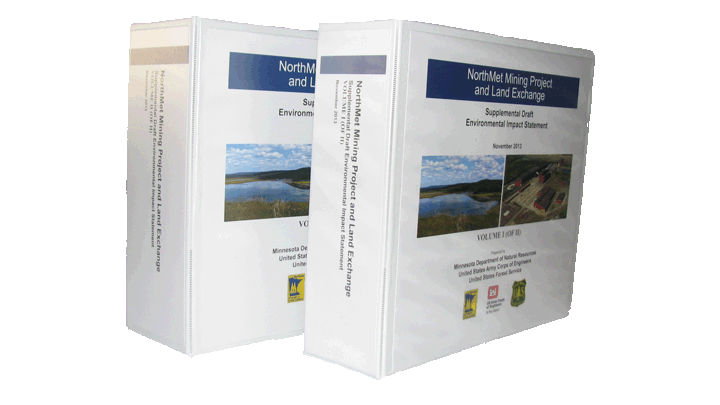PolyMet EIS Update January, 2014
PolyMet's Supplemental Draft Environmental Impact Statement (SDEIS) released to the public Dec 6
Comments will be accepted until 4:30 PM CT on Thursday, March 13, 2014.
There will be public meetings in Aurora, Duluth and St. Paul. Comments will be accepted at these meetings, as well as by email and mail.
Thursday, January 16, 2014 Duluth, DECC
Wednesday, January 22, 2014 Aurora, Mesabi East High School
Tuesday, January 28, 2014 Saint Paul, Saint Paul RiverCentre
Public comments on the SDEIS can be submitted electronically at NorthMetSDEIS.dnr@state.mn.us
Image: PolyMet's proposed NorthMet mine site located on USFS public lands - Superior National Forest, MN

PolyMet Update
The MDNR has said that the release date to the public of PolyMet's NorthMet SDEIS will be December 6
*****
From the MDNR News Release November 6,2013:
Federal shutdown requires modification of the publication date for NorthMet environmental review document
Publication of the Supplemental Draft Environmental Impact Statement (SDEIS) for the NorthMet mining project has been delayed by two weeks due to the recent federal government shutdown, the Minnesota Department of Natural Resources (DNR) announced Nov. 6. The previously identified federal and state publication dates were Nov. 22 and Nov. 25, respectively.
The federal shutdown occurred during critical final review steps for the NorthMet SDEIS. As a result, the federal co-lead agencies were unable to complete their final review under the previous schedule. The additional two weeks, which is slightly less than the total shutdown duration, will allow publication of the SDEIS on Dec. 6 in the Federal Register and Dec. 9 in the EQB Monitor.
Three co-lead agencies – the DNR, the U.S. Army Corps of Engineers and the U.S. Forest Service – have been preparing the SDEIS for the NorthMet proposal for 3½ years. The document examines the state’s first proposed copper, nickel and other precious metal mining operation. Operated by the PolyMet company, the mining project would be located near Hoyt Lakes, and would use the former LTV Steel Mining Company facility.
A supplement to a 2009 draft environmental impact statement, the SDEIS is a significant revision and addition to the original document. The SDEIS will provide the public with the most up-to-date information and environmental analysis of the proposal. The SDEIS is not a permit to mine, but rather a thorough description of the project and an analysis of any environmental impacts it is expected to have. MDNR News Release Found HERE
*****
PolyMet Update from Save Our Sky Blue Waters
November, 2013
PDF of this update linked Here
The PolyMet (also referred to as “NorthMet”) open pit copper/nickel sulfide mine that is currently working its way through the permitting process would be Minnesota’s first to mine nonferrous, sulfide-bearing ore. The proposed mine would be located on what is currently Superior National Forest land between Babbitt and Aurora/Hoyt Lakes.
PolyMet Mining Company began the application process for a permit to mine several years ago. The Minnesota Department of Natural Resources (MDNR) and U.S. Army Corps of Engineers originally released the Draft Environmental Impact Statement for public review in November 2009, but the U.S. Environmental Protection Agency objected to the mine plan because wastewater discharges would not meet water quality standards. This effectively put the permitting process on hold and sent PolyMet back to the drawing board.
In the years since then there have been many false predictions that the next iteration of the Draft EIS (the “Supplemental Draft EIS” or “SDEIS”) would soon be out for public review. In November 2013 the MDNR announced that the release date of PolyMet's SDEIS will be December 6, 2013. A public comment period will begin at that time, including another round of public hearings. We do not yet know how long the comment period will be. The MDNR has said that there will be three public meetings to be held in the Twin Cities, Duluth and Aurora/Hoyt Lakes sometime in January. Exact times and locations will be announced later. Environmental organizations have requested a comment period of 180 days, with public hearings held in Duluth, Ely, and the Twin Cities.
The U.S. Forest Service has joined the Minnesota DNR and the Army Corps of Engineers as a lead agency in preparing the document. The regulatory agencies have made a preliminary draft of the SDEIS available to the public. It is referred to as the “PSDEIS”, and can be accessed at www.friendscvsf.org (with thanks to the Friends of the Cloquet Valley State Forest). Some small changes may be made before the SDEIS is put on public notice, but our understanding is that the mine plan is essentially set and that no significant changes are likely.
We have not had time yet to study the document thoroughly and cannot provide a list of issues at this time. However, many of the reasons we opposed the project in 2009 have not changed:
Destruction of Wetlands. The preliminary draft of the SDEIS predicts that 912 acres of wetlands will be destroyed by filling or excavation, and up to 7,413 acres may be “indirectly” impacted. Indirect impacts include the conversion of wetlands to dry land due to mine dewatering, for which the plan provides no mitigation or replacement. “Mitigation” for the 912 acres of “direct” impacts will occur primarily outside of the St. Louis River/Lake Superior watershed, in an area to the south that is unlikely to support comparable ecosystems and cannot replace the lost functions to the St. Louis River system. The entire mine site has been rated by the Minnesota Biological Survey as of “high biological diversity” and the wetlands are considered by the U.S. EPA to be of national importance “due to the values they provide in terms of unique habitat, biodiversity, downstream water quality and flood control specifically, to the Lake Superior Watershed and the Great Lakes Basin.” The mine site consists of more than 3,000 acres of land, forty percent of which are covered by ecosystems that the Minnesota Biological Survey considers imperiled or vulnerable (black spruce-jack pine woodlands and rich black-spruce swamp).
The need for perpetual water treatment. After the mine is closed, run-off from the site will be polluted and will need treatment for hundreds or even thousands of years. While PolyMet hopes to establish “passive” wetland treatment systems, even these systems will require continued human attention through the centuries. Treatment is likely to be needed beyond the end of our current regulatory or monetary system. We oppose passing such long-lasting environmental problems on to future generations that will not receive the benefit of the activity that caused them.
Cumulative destruction of wildlife habitat. The construction of new mines and expansion of the taconite industry as planned will destroy many miles of wildlife habitat. Wetlands are particularly important for moose, and most of the replacement wetlands that are intended to mitigate the ones that are lost will be located outside of moose territory. Furthermore, the stretch of mines in the Mesabi Range already provides a barrier to wildlife migration. The addition of new mines and the expansion of old ones will effectively block wildlife movement between the regions to the northwest and southeast of the Range.
Negative impacts on the economy. Metal prices are volatile, and the production of minerals is tied to price. Although mining jobs might be high-paying, they are not stable. Studies of mine-dependent communities indicate that they are almost always economically depressed. We do not want to see a mining “boom” bring hundreds of new workers and families to the Northland, only to have them and many of us sent reeling when copper prices drop.
Federal land exchange. Because the proposed mine site is on Forest Service land, a 6,650 acre land exchange is part of the proposal. The policy of exchanging Forest Service land for private lands to facilitate mining is counter to the whole idea of setting aside forested areas for the public. The lands that the Forest Service will receive do not appear to be threatened in any way, and it is unclear what benefit the public will receive by the transfer to public ownership, while the lands that the Forest Service gives up will be deforested. This type of trade will inevitably result in a reduction in total forested acreage and wildlife habitat.
PDF of this update linked Here
* * * * *
From the Duluth News Tribune:
Federal shutdown delays PolyMet environmental review release
By: John Myers, Duluth News Tribune Published November 06, 2013
Last month’s federal government shutdown has caused a two-week delay in the release of the revised environmental-impact statement for the proposed PolyMet copper mine project near Hoyt Lakes.
The Minnesota Department of Natural Resources and U.S. Army Corps of Engineers had said they would release the document to the public Nov. 22, but the release date has been pushed back to Dec. 6.
DNR officials said today that the federal shutdown “occurred during critical final review steps” for the PolyMet so-called Supplemental Draft Environmental Impact Statement. The document, which outlines how the proposed mine will impact the environment and comply with state and federal regulations, will be published Dec. 6 in the Federal Register and Dec. 9 in the state Environmental Quality Board Monitor.
Three agencies — the DNR, Corps and U.S. Forest Service — have been working on the 1,600-page document for more than three years after the original impact statement was considered by federal regulators as inadequate.
“Our federal partners understandably need this time to complete the final review steps that were delayed during the federal shutdown,” DNR Commissioner Tom Landwehr said in a statement today. “While the agencies have worked collectively to minimize schedule impacts from the shutdown, our top priority has always been, and remains, to publish the best possible environmental review of this very complex project.”
The document’s public unveiling will kick off a public review and input period involving public meetings, likely to be held in late January, the DNR said. If and when the EIS is approved, PolyMet still will need to receive a permit from state and federal agencies before construction or mining could begin. That permitting process involves public input.
Toronto-based PolyMet is proposing Minnesota’s first-ever copper mine and processing center, a $600 million open-pit operation that would employ 360 people. Supporters say the mine, which also will process nickel, platinum and other valuable metals, will help diversify the regional economy. Critics say the chances of long-term environmental degradation from acidic mine runoff is not worth the relatively short-term economic benefits.
More info here: http://www.duluthnewstribune.com/event/article/id/282853/group/News/
From the Duluth News Tribune:
PolyMet environmental review to be made public in November
By: John Myers, Duluth News Tribune Published August 23, 2013
The long-awaited revised environmental review of the proposed PolyMet copper mining project will be made public Nov. 24, the Minnesota Department of Natural Resources announced Friday.
The 1,800-page Supplemental Draft Environmental Impact Statement, a detailed plan for how the mine will operate in compliance with state and federal environmental regulations, was compiled by independent contractor EMR and has been years in the making.
The mining project has been substantially reworked since the original version in 2009 to meet concerns of regulatory agencies and others about the long-term implications of emissions, especially potentially acidic runoff when the copper-bearing rock is exposed to water and air.
The new version, originally expected to be made public this summer, also includes the environmental impacts of a proposed land exchange that will allow PolyMet to obtain U.S. Forest Service land where the mine will be located.
Steve Colvin, director of the ecological and water resources division, said the release is several months behind schedule because “of some really good comments that came in’’ from other agencies, such as tribal resource agencies and the Environmental Protection Agency.
“We decided to step back… and take another look,’’ Colvin said Friday.
Once it’s released, the public is expected to have 90 days to comment on the revised mining plan, including at three meetings, which the company has said are likely to be held in the Twin Cities, Duluth and Hoyt Lakes/Aurora. The DNR said those meeting are likely to be held in January. Exact times and locations will be announced later.
DNR officials would say only that the comment period would be “more than 45 days’’ which is the minimum required by law. Environmental groups have asked for 180 days to comment.
“We are taking a hard and objective look at this project,” DNR Commissioner Tom Landwehr said in a statement. “Our top priority has always been to publish the best possible environmental review of a very complex project.”
After taking public comments, the DNR and U.S. Army Corps of Engineers will rework the plan into a final EIS, after which the agencies will make a decision on whether the project can move forward — a so-called “adequacy decision.”
Once that occurs, the company can obtain permits to actually begin construction and mining.
PolyMet in May announced that the environmental review document had been completed and was in the hands of the regulatory agencies which have since been submitting comments, and said the entire package will be made public later this year when another round of meetings will be held and public comments will be accepted.
The company has said it hopes lead agencies will deem the revised environmental review adequate and publish a final EIS early in 2014, with permits to begin mining issued shortly thereafter and construction on the facility starting in the second half of 2014.
PolyMet is proposing Minnesota’s first copper-nickel mine, a $600 million open-pit mine near Babbitt and a processing center at the old LTV taconite mine north of Hoyt Lakes. The project would create about 350 jobs for more than 20 years, plus extensive spinoff business. PolyMet also would recover gold, platinum, palladium and other valuable metals.
Copper mining skeptics continue to have huge concerns over long-term water treatment, noting that documents filed earlier this year for the environmental review show treatment may be required at the PolyMet site for hundreds of years after the mine closes.
Opponents also question PolyMet’s estimates on how much money might be needed to close the mine and cover any environmental cleanup, as high as $200 million of so-called financial assurance. They say that may not be enough to cover long-term treatment of runoff from the mine to protect Northland lakes and rivers.
More info here: http://www.duluthnewstribune.com/event/article/id/275950/
For more information e-mail info@sosbluewaters.org
PO Box 3661 Duluth, Minnesota 55803



